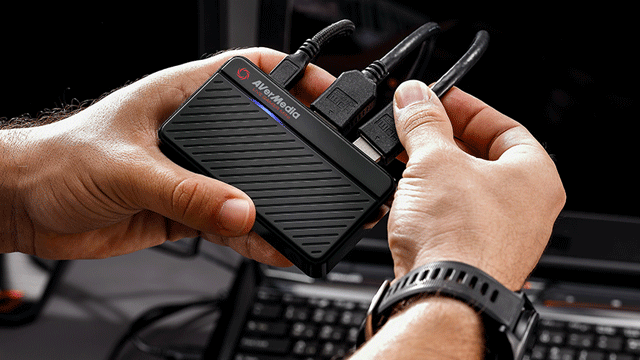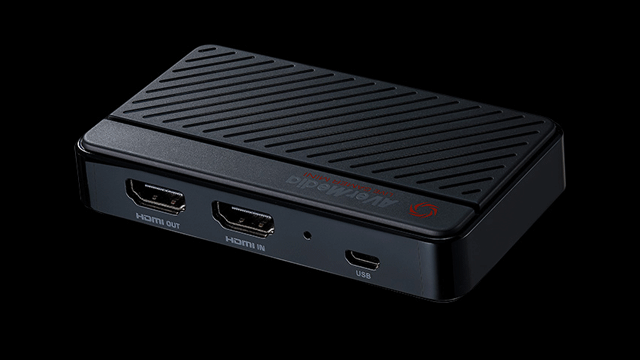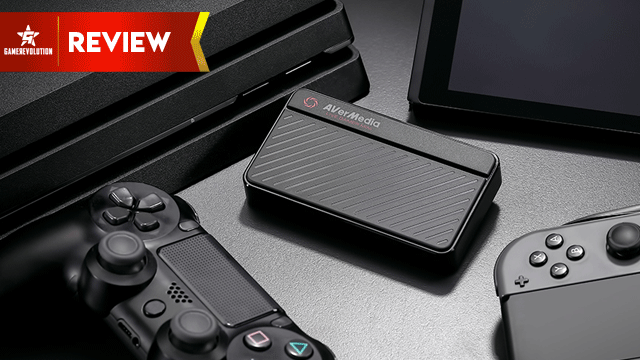Over the last ten years, gameplay capture solutions have evolved to record resolutions of up to 4K, frame-rates surpassing 100 FPS, and even HDR. Products like the Avermedia Live Gamer Ultra and 4K are the flagships pushing what’s possible for external and internal devices. However, they don’t come cheap, and their features may be overkill for some content creators. Enter our Avermedia Live Gamer Mini review, in which I take a look at an entry-level product that aims to satisfy with a lower price tag, but with 1080p 60 FPS recordings that still look fantastic.
Avermedia Live Gamer Mini Review | The starting point

The Live Gamer Mini comes in a rather barebones package, with its box only containing a paper guide, a micro USB, and the product itself. (No, there is no HDMI provided, so bear that in mind when planning your setup.) And yes, I did say “micro USB,” as this device does indeed use USB 2.0. Despite this, for the 1080p 60 FPS gameplay users will be capturing and streaming, the speed of USB 2.0 shouldn’t prove to be too much of a hindrance, and it will perhaps allow the device to work more reliably on older or less conventional PC and laptop hardware.
What’s more, driverless support (via UVC Protocol) means the Mini can be recognized by Windows and Mac computers without installing additional software. It’s as simple as plugging in and playing, with software like OBS immediately recognizing the device. With that said, installing the latest version of the RECentral 4 application does allow access to the product’s full selection of features.
Buy the Avermedia Live Gamer Mini on Amazon
When it comes to the Mini’s design, you have probably already guessed that it’s pretty small. Yes, that “Mini” name certainly hints at the fact that this is the smallest device Avermedia has ever released. This makes it less of an obstacle when packing it into a bag and doesn’t take up much space on a desk. When powered on, there is an indicator light which blinks red or blue depending on the action. I like this a lot, as it provides a quick visual clue as to whether or not you’re recording/streaming.

Providing the user has their own HDMI cable/s available, setup is very simple. The micro USB provides both power and data transfer, and then a HDMI leads from the console/PC to the device. A second HDMI can run from the HDMI Out to a television or monitor to pass the image through with near to zero latency. I’d highly recommend this as, while it’s possible to monitor footage on the PC/laptop you’re capturing on, the slight delay is really only manageable for games that don’t require fast reactions.
While Avermedia’s Live Gamer 4K and Ultra devices do boast HDR compatibility, the cheaper Mini does not. Images passed through the Mini will be 1080p 60 FPS SDR maximum, as it neither captures nor passes through 4K or HDR video. So if you’ve got a fancy 4K HDR TV, and a PS4 Pro/Xbox One X, and you want to enjoy HDR content, you’ll be needing to pay more to get that feature.
Avermedia Live Gamer Mini Review | Software successes

As I’ve stated in all of my Avermedia product reviews over the last year, the software experience is now finally on par with the hardware. RECentral 4 is fantastic, especially when compared to previous versions. I no longer experience any errors or crashes, and I thank Avermedia for finally getting it right. It was the main headache that prevented me from using Avermedia as a daily driver, but now those issues are solved.
With RECentral 4, users can create a bunch of capture profiles, set up different streaming windows, mix audio from a range of sources, and crop current recordings.
Below you’ll find Apex Legends gameplay running at 1080p 60 FPS, captured with a bitrate of 30 Mbps. It has been uploaded to YouTube, where the platform’s own compression can lead to a significant quality reduction. Take what you see as the worst case scenario, which is what your viewers will see if you choose the Mini as your entry point to content creation. (It still looks pretty damn good to me!)
However, if RECentral 4 isn’t for you, and you prefer OBS instead, then you’ll be happy to hear that the Live Gamer Mini works without issue. I’ve captured and streamed gameplay using OBS, and it’s as flawless as you would expect. You can also make use of OBS’ “Replay Buffer” to ensure you never miss a moment. Here’s hoping Avermedia can implement this into RECentral soon, though “Live Editing” is an okay alternative.
The “Stream Engine” is also worth mentioning, as this allows streamers to broadcast low bitrate footage with overlays to Twitch, etc. while also recording a high bitrate copy of the gameplay without overlays. This can prove incredibly useful when you require high-quality clips without those stream overlays, for montages or highlights on YouTube.
If you’ve been capturing gameplay using the built-in functionality of the PS4 or Xbox One, and are looking to up the quality and length of your gameplay clips, then the Mini and RECentral 4/OBS combo makes for a great upgrade.
Avermedia Live Gamer Mini Review | Budget champ

I’ve used a lot of Avermedia’s capture devices over the years and that’s why the Mini has been a confusing product to review in 2019. Though it’s perfectly fine at capturing 1080p 60 FPS gameplay, it’s a little too similar to 2016’s Live Gamer Portable 2. I actually reached out to Avermedia asking what the point of the Mini is, when the LGP 2 already existed. A rep told me it was mostly about the new smaller size and overall cheaper price. This is aimed at beginner content creators who want the best budget option.
While I’m a big fan of Avermedia looking to both innovate in its high-end products, while also revamping its budget line-up, I still have to say that the LGP 2’s ability to record to an SD card in the PC-Free mode (which is great for single PC capture with no impact on performance!), as well as the additional 3.5 mm line in and out ports, make it the more enticing product.
At the time of writing, the LGP 2 is selling for $149.99, while the Live Gamer Mini is retailing for $129.99. For my money, that $20 premium is well worth gaining access to PC-Free capture and additional audio input and monitoring. However, for a beginner content creator, I suppose that $20 could be better spent on a webcam, new headphones, or something more useful. I just feel it’s important to point out that, despite being released in 2016, the Live Gamer Portable 2 still packs a hell of a punch!
As for the competition, Elgato’s HD60 S is the clear competitor, but it is still sitting at $164.85 on Amazon. The standard HD60 should be available for less, but it’s difficult to track down. When it comes to external capture solutions, Elgato seems to have slowed down a little, leaving a gap open for well-priced entry-level hardware like the Live Gamer Mini.
For now, Avermedia seems to have the best deals when it comes to gameplay capture devices, and I’d highly recommend the Mini to any gamers looking to start creating content.
Live Gamer Mini review unit was provided by Avermedia.











